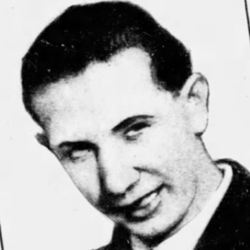 St. Louis Post-Dispatch, May 15, 1932. At about 1:30 a.m. on January 7, 1929, Deputy Sheriff J.W. Dugan of Herculaneum, Missouri, was awakened by a phone call from Virgil Romine, calling for help from the Artesian Park Filling Station. Dugan rushed to the station, where he found Romine bleeding profusely from fresh bullet wounds in his abdomen. L.H. Jones, the owner of the station, and Dr. O.E. Hensley arrived shortly thereafter. Despite Romine’s injuries, when asked by Sheriff Dugan to describe his attacker, he said, “I can’t tell you their names, but you can find out. It is the same fellows I had trouble with up here a couple of weeks ago over the slugging of a slot machine and I run them away that night and they ran off and left their automobile here.” The car, Romine continued, which was impounded by Jones, was returned to the boys when they paid Jones the 75 cents they owed him for slugging the machine. (Slugging is defined as the use of a counterfeit metal “slug” in a slot machine). Romine also told the sheriff that “the fellows are often seen around old lady Vinyard’s place.” After making what would turn out to be his dying statement, Romine was taken to a hospital in St. Louis. Recalling the event, Jones informed Sheriff Dugan that the boys who had slugged the slot machine were 19-year-old Alvin Craig and Walter Hess from Crystal City. Dugan drove to the Vinyard residence, where he found Mrs. Vinyard, Craig, and Hess. In response to Sheriff Dugan’s questions, the boys claimed that they had never left the house the night of the murder, and Mrs. Vinyard confirmed their statements. The boys did, however, admit to having had trouble with Romine over the slot-machine slugging incident. Since Romine had said positively that his assailant was one of the boys who had slugged the slot machine, and taking their bad reputations into account, Sheriff Dugan arrested Craig and Hess. The following morning, January 8, a crew of men working for the State Highway Department found overalls and a pair of trousers, both of which bore blood stains, approximately one mile north of the filling station. These were thrown on a fire and burned. A short while later, a white shirt with a bloody sleeve, and a colored shirt with a hole in it were found. Fortunately, these shirts were turned over to the St. Louis Police Department. Later that day, the police received word that potential witnesses Leo Bassler and Dewey Grieshaber had been in the Artesian Restaurant after 1:00 a.m. on January 7. Bassler and Grieshaber related that just before they left the restaurant, three young men and a young woman dressed in men’s clothes entered the restaurant. Neither Bassler nor Grieshaber could positively identify Craig or Hess as among those in the party, but their descriptions of two of the men matched the accused boys. In addition, John Bechler, county treasurer and a respected citizen of Jefferson County, reported that on the morning of the murder, he saw automobile headlights coming toward Mrs. Vinyard’s house, and heard Hess say to his friend Craig, “Here comes the law.” Hess denied making this statement. Exactly one week after the murder, Prosecutor Charles W. Green filed an indictment against Craig and Hess, charging them with murder. Their trial began on April 18, 1929, and the following day they were convicted of second-degree murder, based largely on Romine’s statement made shortly before his death and Hess’s “Here comes the law” comment, allegedly overheard by Bechler. No physical evidence linked the boys to the murder. Nevertheless, Craig and Hess were sentenced to ten years. Before their cases were appealed, Mamie (Babe) Woolem, a resident of a nearby town, went to the St. Louis Police Department and volunteered information that she had accompanied her ex-boyfriend, Louis Taylor, and two of his friends, Radford Browning, and Joe Muehlman, to Herculaneum on the night Romine had been shot. She had recently learned that Taylor had been unfaithful to her and willingly told the police that he had shot the victim. The three men were immediately arrested and questioned. Taylor initially claimed to have no knowledge about the case. The police requested that he wear the blue shirt with the bullet hole that was recovered the day after the murder. A scar was found on his body where the hole in the shirt was located. Based on this revelation, Taylor and his friends confessed that they had planned to rob the station and Taylor had shot the victim. One year after their convictions, Craig and Hess were pardoned by Governor Henry S. Caulfield based on innocence. Tried and convicted for the murder of Romine, Taylor received a life sentence. Browning and Muehlman were sentenced to ten years. Mamie (Babe) Woolem claimed she knew nothing about the plan to rob the filling station. However, Taylor turned state’s witness against her and testified that she had planned the hold-up herself and had supplied him with the gun used to kill Romine. She stood trial, was convicted, and given a life sentence. - Marc Jeker
|